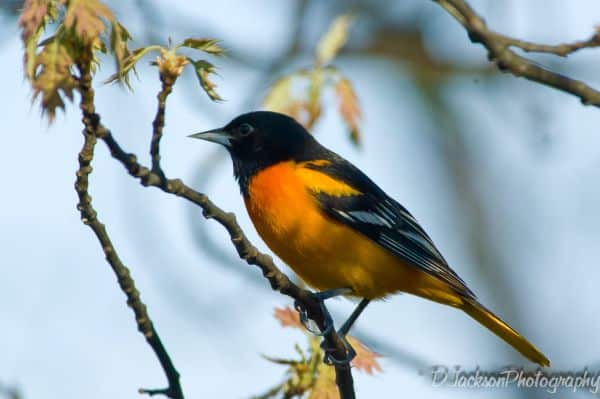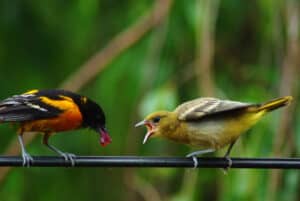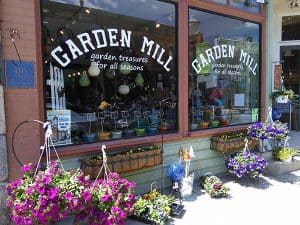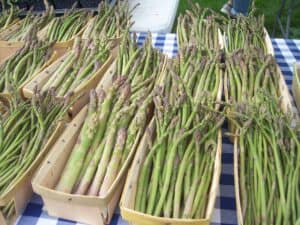
By Master Naturalist Doug Jackson
Vibrant and inspiring cousins of the rather ordinary and uninspiring blackbirds are the orioles.
There are eight species of orioles that breed in the United States, two of which breed here in the Eastern half of the U.S., the Baltimore Oriole and the Orchard Oriole.
The Baltimore Oriole is most commonly seen here in Michigan not far from water, whether lake, stream, or pond, and in woods or neighborhoods with tall deciduous trees.

While the Orchard Oriole is less commonly seen and can be found near forest edges with open fields as well as in suburban settings.
The subject of this article, the Baltimore Oriole, is a popular favorite summertime visitor with many bird feeding enthusiasts. It is no wonder, due to its beautiful, rich whistling songs that match its striking bright colors. The male has a black head and wings that boldly contrast with his bright orange body, while the female tends to be a less bright orange with brownish wings.
Unlike most birds, the orioles seem to have unique songs for each individual. I have one that sings a phase that sounds like, “liar, liar, pants on fire,” while another sings “Hey, batter, batter, batter, SWING!”
The Baltimore Oriole’s scientific name, Icterus Galbula, is comprised of a Greek and a Latin word, both for “yellow bird.” Their common name was derived from their colors as well. The coat-of-arms of Lord Baltimore includes a bold orange and black checker pattern which we can observe in Maryland’s state flag.

Baltimore Orioles migrate from the tropics of Central America to these parts of Michigan by the beginning of May. Upon arrival, they are craving sugary foods to help replenish their fat supply used up on their flight north. This makes foods like oranges and Concord grape jelly irresistible to these birds, and a popular way to attract them to our yards.
The females begin weaving new hanging nests each year high up in deciduous trees. The pair gathers certain fibers from plants such as swamp milkweed, tall grasses, and cotton wood seeds that the female weaves as skillfully as the most expert artisan. These hanging baskets are so well woven that they last well into late fall, well after the orioles have migrated back south in September.
Those wishing to attract orioles to their yards need the right habitat. Habitat is more than just feeder food. It includes natural foods, shelter, and space. These birds prefer to build their nests in mature elms or cottonwood trees and to be near water.
Due to the loss of many of our elms to Dutch Elm disease, these birds have adapted to nest in other large deciduous trees such as maples, willows, apple and oaks, as well as moving into more suburban settings as forests and wetlands give place to urban sprawl. However, modern urban landscaping has been including many non-native plantings such as the popular Bradford Pears and Norway Maples.
Non-native plantings, whether flowering shrubs or trees, are of no benefit to our wildlife and do nothing to attract or sustain it. In fact, trees such as Bradford Pears can spread rapidly in the wild and displace native plants, thus reducing critically beneficial habitat for wildlife. Thus, replacing non-native plants with trees and shrubs native to Michigan is an excellent way of attracting and sustaining our wildlife such as birds and butterflies.

Orioles preferred food includes insect larvae, dark fruits, and nectar that can all be found amongst our native plants. Orange slices and small servings of grape jelly placed in a dish or home-made Frisbee feeder (as pictured here) can also help attract local orioles to your yard. You may also see them frequent hummingbird feeders. If you wish to mix some nectar specifically for the orioles, a 6:1 ratio of boiled water to white sugar works well. Keep your feeders regularly supplied, and they may bring their young to visit your feeders as well.
A fun fact is that these fruit loving birds can be seen using their unique gaping technique to eat. They pierce the fruit with their bills, pry open a hole, and lick out the juices with their bristly tongues.
As summer progresses, you may notice that they are visiting the feeders less often. This is because they are now focusing on feeding their young with protein rich foods found in caterpillars and other insect larvae dwelling in our native tree foliage. But come closer to migration, these birds and their young will want to sugar-up again to build up fat energy for their journey south.
Attracting wildlife to your yard can be enjoyable, but requires good stewardship and responsibility. Keeping feeders and the areas around them clean help to prevent disease and nuisance wildlife such as raccoons and skunks from frequenting your yard. Rather than imported ornamental, plants, natives such as mulberry, raspberry, crab apple, and trumpet vine are all attractive food sources for orioles and other birds and insects.
Orioles are not only beautiful to observe, but also can help inspire us all to be better stewards of our property and the wildlife we wish to attract.


















